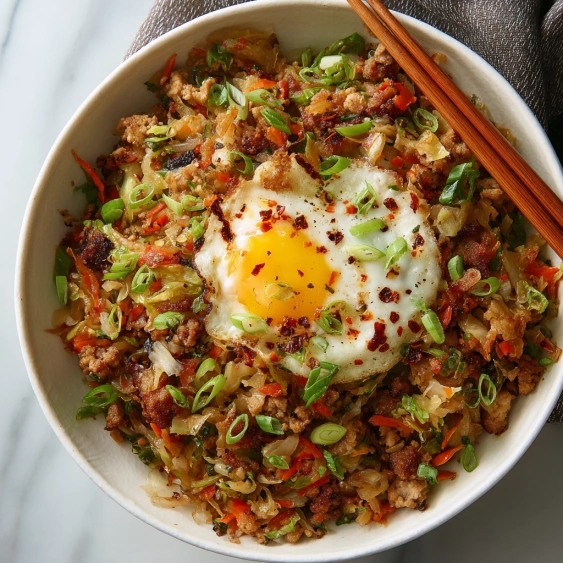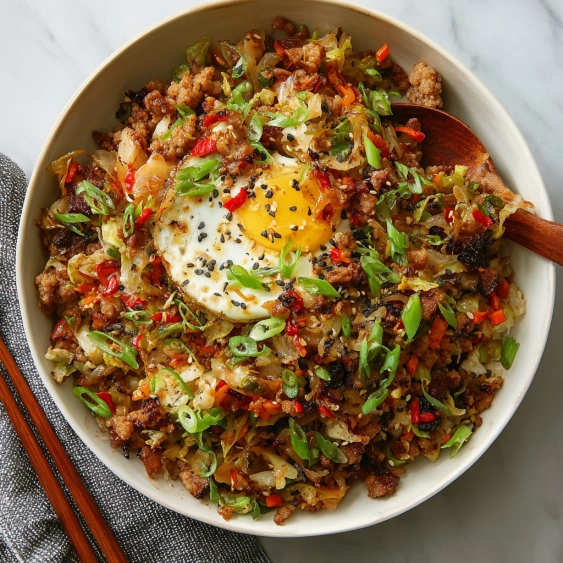 Pin it
Pin it
This egg roll in a bowl takes all the delicious flavors of traditional egg rolls but eliminates the deep-frying and wrapping for a quick, healthy weeknight dinner that still satisfies those takeout cravings. I created this recipe when trying to cut carbs but still wanted the comfort of Chinese food.
I first made this during a particularly hectic week when I needed something quick but didn't want to resort to ordering takeout again. My family now requests it regularly, even preferring it to actual egg rolls.
Ingredients
- Ground turkey: Provides lean protein without being too heavy. Look for 93% lean for the best flavor without excess fat
- Sesame oil: The distinctive nutty flavor that gives this dish its authentic Asian taste. Use toasted sesame oil for maximum impact
- Garlic clove: Fresh garlic adds aromatic depth. Choose firm bulbs with tight skin
- Scallions: Adds bright color and mild onion flavor. Look for firm stalks with vibrant green tops
- Mushrooms: Creates meaty texture and umami flavor. Shiitake work wonderfully but button mushrooms are fine too
- Coleslaw mix: The perfect shortcut. The pre-shredded cabbage and carrots save tons of prep time
- Ginger powder: Brings warmth and spice. Check that yours is fresh and fragrant
- Garlic powder: Reinforces the garlic flavor throughout the dish
- Soy sauce: Provides the salty umami base. Low sodium allows you to control the salt level
Step-by-Step Instructions
- Brown the Turkey:
- Heat 1 tablespoon sesame oil in a large skillet over medium heat until shimmering. Add ground turkey and break it into small pieces with a wooden spoon. Season with a pinch of salt and pepper. Cook for about 6 minutes, stirring occasionally until the meat is no longer pink and slightly browned on edges. Transfer the cooked turkey to a bowl and set aside.
- Sauté the Vegetables:
- Add another tablespoon of sesame oil to the same pan. Add minced garlic and cook for about 1 minute until fragrant but not browned. Add scallions, mushrooms, and coleslaw mix. Sprinkle with ginger powder, garlic powder, salt and pepper. Stir to combine and cook for 5 to 7 minutes, until vegetables are softened but still have a slight crunch.
- Combine and Finish:
- Return the cooked turkey to the pan with the vegetables. Add the remaining 1/2 tablespoon of sesame oil and the soy sauce. Stir everything together, ensuring the sauce coats all ingredients evenly. Cook for an additional 2 minutes to allow flavors to meld together. The cabbage should be tender but not mushy.
- Serve and Garnish:
- Spoon the mixture into bowls. Serve as is for a low carb meal or over steamed rice for a more filling option. Garnish with fresh scallions, sesame seeds, and a drizzle of Sriracha for heat if desired.
 Pin it
Pin it
My absolute favorite part of this dish is the sesame oil. I learned from my grandmother that you should never skimp on quality sesame oil as it forms the aromatic foundation of many Asian dishes. The nutty aroma that fills my kitchen when it hits the hot pan instantly transports me back to her tiny kitchen where I first learned to cook.
Make It Your Own
This egg roll bowl is incredibly adaptable to different dietary needs and preferences. Try ground chicken, pork, or beef instead of turkey. For a vegetarian version, substitute crumbled tofu or tempeh. The key is maintaining that balance of protein with the crisp vegetables and savory sauce.
 Pin it
Pin it
Storage Tips
This dish keeps beautifully in the refrigerator for up to four days, making it perfect for meal prep. Store in airtight containers and reheat in the microwave for about two minutes or in a skillet over medium heat. The flavors actually develop and improve after a day in the refrigerator as everything marinates together.
Serving Suggestions
While delicious on its own, this egg roll bowl pairs wonderfully with steamed jasmine rice or cauliflower rice for a lower carb option. For a complete takeout experience at home, serve alongside some store bought or homemade dumplings. A crisp cucumber salad dressed with rice vinegar makes a refreshing side that balances the savory warmth of the main dish.
The History Behind It
Deconstructed dishes like this egg roll bowl represent modern Asian American cooking at its finest blending traditional flavors with contemporary health consciousness. While egg rolls themselves have a complex history spanning Chinese American cuisine development in the early 20th century, this bowl version emerged during the low carb diet trends of recent decades but has stayed popular because of its genuine flavor and convenience.
Frequently Asked Questions
- → What protein alternatives work in this egg roll bowl?
Ground chicken, beef, or pork work excellently as alternatives to turkey. For vegetarian options, crumbled tofu or tempeh can be substituted and seasoned similarly, providing comparable texture and protein content while absorbing the Asian flavors beautifully.
- → Can I make this dish ahead of time?
Yes! This dish stores wonderfully in the refrigerator for 3-4 days. For best results when reheating, use a skillet on medium heat rather than a microwave to maintain the vegetables' texture. You may want to add a splash of soy sauce or sesame oil to refresh the flavors.
- → How can I increase the vegetable content?
You can easily double the coleslaw mix or add shredded carrots, thinly sliced bell peppers, bean sprouts, or chopped bok choy. These additions maintain the authentic flavor profile while boosting nutritional value and adding texture variety.
- → What are the best side dishes to serve with this?
While delicious on its own, this dish pairs wonderfully with steamed jasmine rice, cauliflower rice for a low-carb option, or simple vegetable sides like steamed broccoli. For a complete Asian-inspired meal, serve with a side of vegetable potstickers or a simple miso soup.
- → How can I make this dish spicier?
Beyond drizzling with Sriracha, you can add heat by incorporating red pepper flakes during cooking, mixing in sambal oelek or chili-garlic sauce with the soy sauce, or adding thinly sliced fresh jalapeños or Thai chilies with the vegetables.
- → Is this dish gluten-free?
To make this gluten-free, simply substitute regular soy sauce with tamari or coconut aminos as mentioned in the ingredients list. Double-check your sesame oil and other packaged ingredients to ensure they're certified gluten-free.
